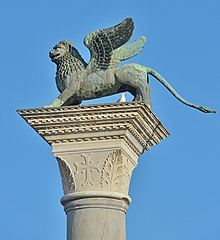
Back Lleó de Venècia Catalan León de Venecia Spanish Վենետիկի առյուծ Armenian ヴェネツィアの獅子 Japanese Leão de Veneza Portuguese 威尼斯之狮 Chinese
| The Lion of Venice | |
|---|---|
 The Lion of Venice | |
| Artist | Unknown |
| Year | c. 600-900 a.d. (disputed) |
| Type | Bronze |
| Location | Piazza San Marco Venice, Italy |



The Lion of Venice is an ancient bronze sculpture of a winged lion in the Piazza San Marco of Venice, Italy, which came to symbolize the city—as well as one of its patron saints, St Mark—after its arrival there in the 12th century. The sculpture surmounts one of two large granite columns in the Square, thought to have been erected between 1172 and 1177 during the reign of Doge Sebastiano Ziani[1] or about 1268,[2] bearing ancient symbols of the two patron saints of Venice.
The Lion sculpture has had a very long and obscure history, probably starting its existence as a funerary statue called zhènmùshòu (镇墓兽 in Simplified Chinese, literally “tomb guardian”) in medieval China, during the reign of the Tang Dynasty.[3] Earlier studies argued that it might instead come from a winged lion-griffin statue on a monument to the god Sandon at Tarsus in Cilicia, perhaps cast around 300 BC.[4] The figure, which stands on the eastern column, at some point came to represent the Lion of Saint Mark, traditional symbol of Saint Mark the evangelist. The figure standing on the western column is St. Theodore of Amasea, patron of the city before St Mark, who holds a spear and stands on a crocodile (to represent the dragon which he was said to have slain). It is also made up of parts of antique statues and is a copy, the original being kept in the Doge's Palace.
- ^ Madden, Thomas F., Venice: islands of honor and profit: a new history (2012), Penguin Books, p. 98.
- ^ Maguire, Henry and Robert S. Nelson, editors (2010), San Marco, Byzantium and the Myths of Venice (Dumbarton Oaks Byzantine Symposia and Colloquia); Dumbarton Oaks Research Library and Collection, pg 79 and note 10 on pg 10.
- ^ Artioli, Gilberto; Angelini, Ivana; Vidale, Massimo (2024-12-05). "A 'Lion' on the Silk Road". Reimagining the Silk Roads. London: Routledge. p. 110–128. doi:10.4324/9781003348702-10. ISBN 978-1-003-34870-2.
- ^ Scarfi, Bianca Maria, ”The Bronze Lion of St Mark” (1990); In: Scarfi, Bianca Maria, editor, The Lion of Venice: Studies and Research on the Bronze Statue in the Piazzetta, Prestel Publishing, pp. 31-124.